An Analysis of Safety Leadership Roles: Directors and Site Managers
VerifiedAdded on 2020/04/13
|10
|2614
|31
Report
AI Summary
This report delves into the multifaceted aspects of safety leadership, examining the distinct yet interconnected roles of directors and site managers in fostering a safe and healthy work environment. It begins by defining safety leadership and differentiating it from management, emphasizing the ...

Running Head: Health and Safety 1
Health and safety
Health and safety
Paraphrase This Document
Need a fresh take? Get an instant paraphrase of this document with our AI Paraphraser
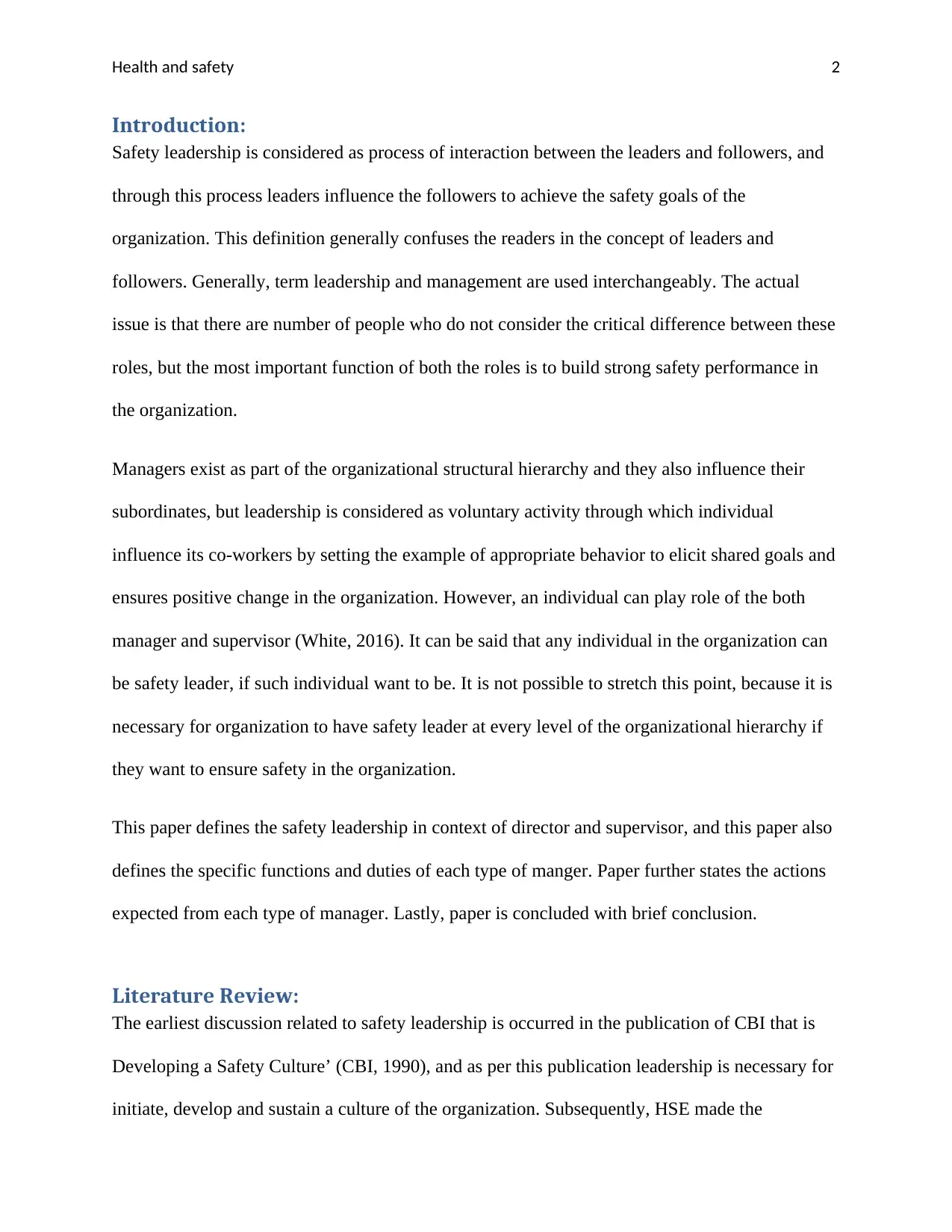
Health and safety 2
Introduction:
Safety leadership is considered as process of interaction between the leaders and followers, and
through this process leaders influence the followers to achieve the safety goals of the
organization. This definition generally confuses the readers in the concept of leaders and
followers. Generally, term leadership and management are used interchangeably. The actual
issue is that there are number of people who do not consider the critical difference between these
roles, but the most important function of both the roles is to build strong safety performance in
the organization.
Managers exist as part of the organizational structural hierarchy and they also influence their
subordinates, but leadership is considered as voluntary activity through which individual
influence its co-workers by setting the example of appropriate behavior to elicit shared goals and
ensures positive change in the organization. However, an individual can play role of the both
manager and supervisor (White, 2016). It can be said that any individual in the organization can
be safety leader, if such individual want to be. It is not possible to stretch this point, because it is
necessary for organization to have safety leader at every level of the organizational hierarchy if
they want to ensure safety in the organization.
This paper defines the safety leadership in context of director and supervisor, and this paper also
defines the specific functions and duties of each type of manger. Paper further states the actions
expected from each type of manager. Lastly, paper is concluded with brief conclusion.
Literature Review:
The earliest discussion related to safety leadership is occurred in the publication of CBI that is
Developing a Safety Culture’ (CBI, 1990), and as per this publication leadership is necessary for
initiate, develop and sustain a culture of the organization. Subsequently, HSE made the
Introduction:
Safety leadership is considered as process of interaction between the leaders and followers, and
through this process leaders influence the followers to achieve the safety goals of the
organization. This definition generally confuses the readers in the concept of leaders and
followers. Generally, term leadership and management are used interchangeably. The actual
issue is that there are number of people who do not consider the critical difference between these
roles, but the most important function of both the roles is to build strong safety performance in
the organization.
Managers exist as part of the organizational structural hierarchy and they also influence their
subordinates, but leadership is considered as voluntary activity through which individual
influence its co-workers by setting the example of appropriate behavior to elicit shared goals and
ensures positive change in the organization. However, an individual can play role of the both
manager and supervisor (White, 2016). It can be said that any individual in the organization can
be safety leader, if such individual want to be. It is not possible to stretch this point, because it is
necessary for organization to have safety leader at every level of the organizational hierarchy if
they want to ensure safety in the organization.
This paper defines the safety leadership in context of director and supervisor, and this paper also
defines the specific functions and duties of each type of manger. Paper further states the actions
expected from each type of manager. Lastly, paper is concluded with brief conclusion.
Literature Review:
The earliest discussion related to safety leadership is occurred in the publication of CBI that is
Developing a Safety Culture’ (CBI, 1990), and as per this publication leadership is necessary for
initiate, develop and sustain a culture of the organization. Subsequently, HSE made the

Health and safety 3
publication that is Organizing for Safety’ (HSC, 1993), and this publication defines dominant
themes that are importance of leadership in the organization and commitment towards the safety
of the chief executive, role of executive in safety line management, involvement of all the
employees, openness of the communication, and care and concern for all those stakeholders who
get affected from the business.
Evidently, leaders of the organization were being encouraged to consider the safety as part of
their role with some initial suggestions such as employee engagement in safety management,
effective communication, etc.
After the publication of CBI, practical guide was produced by the Health and Safety Executive
(HSE), and this guide named as ‘Successful Health and Safety Management’ (HSG65) in 1991.
Department also issued latest version of this guide in 2013 ‘Managing for health and safety’, and
this guide also include ‘Plan, Do, Check, Act’ model for the purpose of safety management. This
guide includes the notes which states that leaders must consider the risk profiling and show
commitment towards safety by providing safe working environment, set objectives in this
context, monitor performance, and also engage their workforce. Notes stated in the guide are
provided for particular industry sector such as construction (HSE, 2012) or major hazard
industries (HSE, 2004) and briefing documents (The IET, 2012), and these notes encourage the
leaders of the organization to promote safety in their organization as part of their responsibility.
Judith Hackitt, Chair of the HSE (HSE, 2009) Company Secretaries and Administrators in 2009
adopt an approach in this regard, and this approach supports the view that safety leadership is
broadly defined when safety is considered as important part of the leadership role. However,
academic and practitioner literatures on safety and some guidance notes on safety consider the
safety leadership approach more restrict in practice, because it only focus on those practices that
publication that is Organizing for Safety’ (HSC, 1993), and this publication defines dominant
themes that are importance of leadership in the organization and commitment towards the safety
of the chief executive, role of executive in safety line management, involvement of all the
employees, openness of the communication, and care and concern for all those stakeholders who
get affected from the business.
Evidently, leaders of the organization were being encouraged to consider the safety as part of
their role with some initial suggestions such as employee engagement in safety management,
effective communication, etc.
After the publication of CBI, practical guide was produced by the Health and Safety Executive
(HSE), and this guide named as ‘Successful Health and Safety Management’ (HSG65) in 1991.
Department also issued latest version of this guide in 2013 ‘Managing for health and safety’, and
this guide also include ‘Plan, Do, Check, Act’ model for the purpose of safety management. This
guide includes the notes which states that leaders must consider the risk profiling and show
commitment towards safety by providing safe working environment, set objectives in this
context, monitor performance, and also engage their workforce. Notes stated in the guide are
provided for particular industry sector such as construction (HSE, 2012) or major hazard
industries (HSE, 2004) and briefing documents (The IET, 2012), and these notes encourage the
leaders of the organization to promote safety in their organization as part of their responsibility.
Judith Hackitt, Chair of the HSE (HSE, 2009) Company Secretaries and Administrators in 2009
adopt an approach in this regard, and this approach supports the view that safety leadership is
broadly defined when safety is considered as important part of the leadership role. However,
academic and practitioner literatures on safety and some guidance notes on safety consider the
safety leadership approach more restrict in practice, because it only focus on those practices that
⊘ This is a preview!⊘
Do you want full access?
Subscribe today to unlock all pages.

Trusted by 1+ million students worldwide
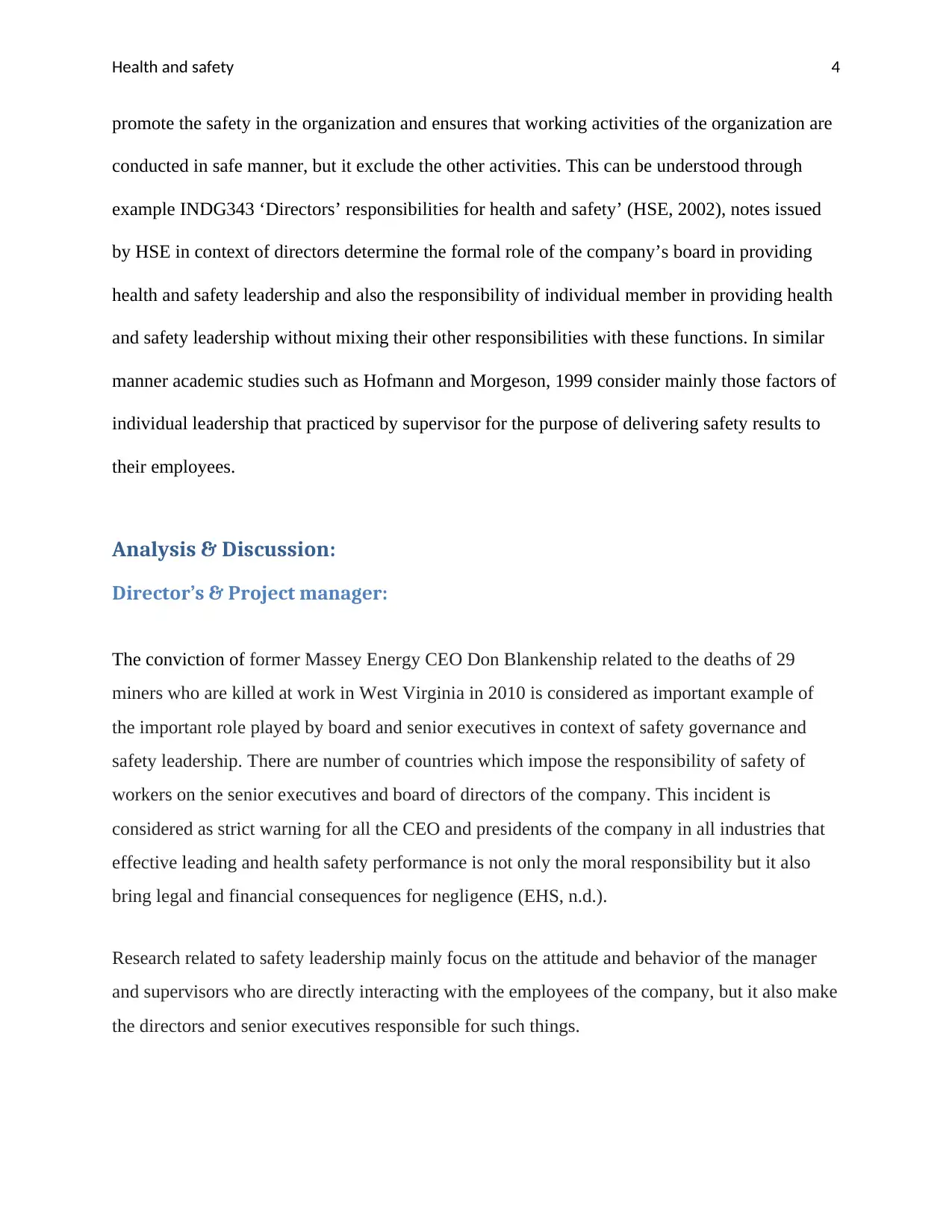
Health and safety 4
promote the safety in the organization and ensures that working activities of the organization are
conducted in safe manner, but it exclude the other activities. This can be understood through
example INDG343 ‘Directors’ responsibilities for health and safety’ (HSE, 2002), notes issued
by HSE in context of directors determine the formal role of the company’s board in providing
health and safety leadership and also the responsibility of individual member in providing health
and safety leadership without mixing their other responsibilities with these functions. In similar
manner academic studies such as Hofmann and Morgeson, 1999 consider mainly those factors of
individual leadership that practiced by supervisor for the purpose of delivering safety results to
their employees.
Analysis & Discussion:
Director’s & Project manager:
The conviction of former Massey Energy CEO Don Blankenship related to the deaths of 29
miners who are killed at work in West Virginia in 2010 is considered as important example of
the important role played by board and senior executives in context of safety governance and
safety leadership. There are number of countries which impose the responsibility of safety of
workers on the senior executives and board of directors of the company. This incident is
considered as strict warning for all the CEO and presidents of the company in all industries that
effective leading and health safety performance is not only the moral responsibility but it also
bring legal and financial consequences for negligence (EHS, n.d.).
Research related to safety leadership mainly focus on the attitude and behavior of the manager
and supervisors who are directly interacting with the employees of the company, but it also make
the directors and senior executives responsible for such things.
promote the safety in the organization and ensures that working activities of the organization are
conducted in safe manner, but it exclude the other activities. This can be understood through
example INDG343 ‘Directors’ responsibilities for health and safety’ (HSE, 2002), notes issued
by HSE in context of directors determine the formal role of the company’s board in providing
health and safety leadership and also the responsibility of individual member in providing health
and safety leadership without mixing their other responsibilities with these functions. In similar
manner academic studies such as Hofmann and Morgeson, 1999 consider mainly those factors of
individual leadership that practiced by supervisor for the purpose of delivering safety results to
their employees.
Analysis & Discussion:
Director’s & Project manager:
The conviction of former Massey Energy CEO Don Blankenship related to the deaths of 29
miners who are killed at work in West Virginia in 2010 is considered as important example of
the important role played by board and senior executives in context of safety governance and
safety leadership. There are number of countries which impose the responsibility of safety of
workers on the senior executives and board of directors of the company. This incident is
considered as strict warning for all the CEO and presidents of the company in all industries that
effective leading and health safety performance is not only the moral responsibility but it also
bring legal and financial consequences for negligence (EHS, n.d.).
Research related to safety leadership mainly focus on the attitude and behavior of the manager
and supervisors who are directly interacting with the employees of the company, but it also make
the directors and senior executives responsible for such things.
Paraphrase This Document
Need a fresh take? Get an instant paraphrase of this document with our AI Paraphraser
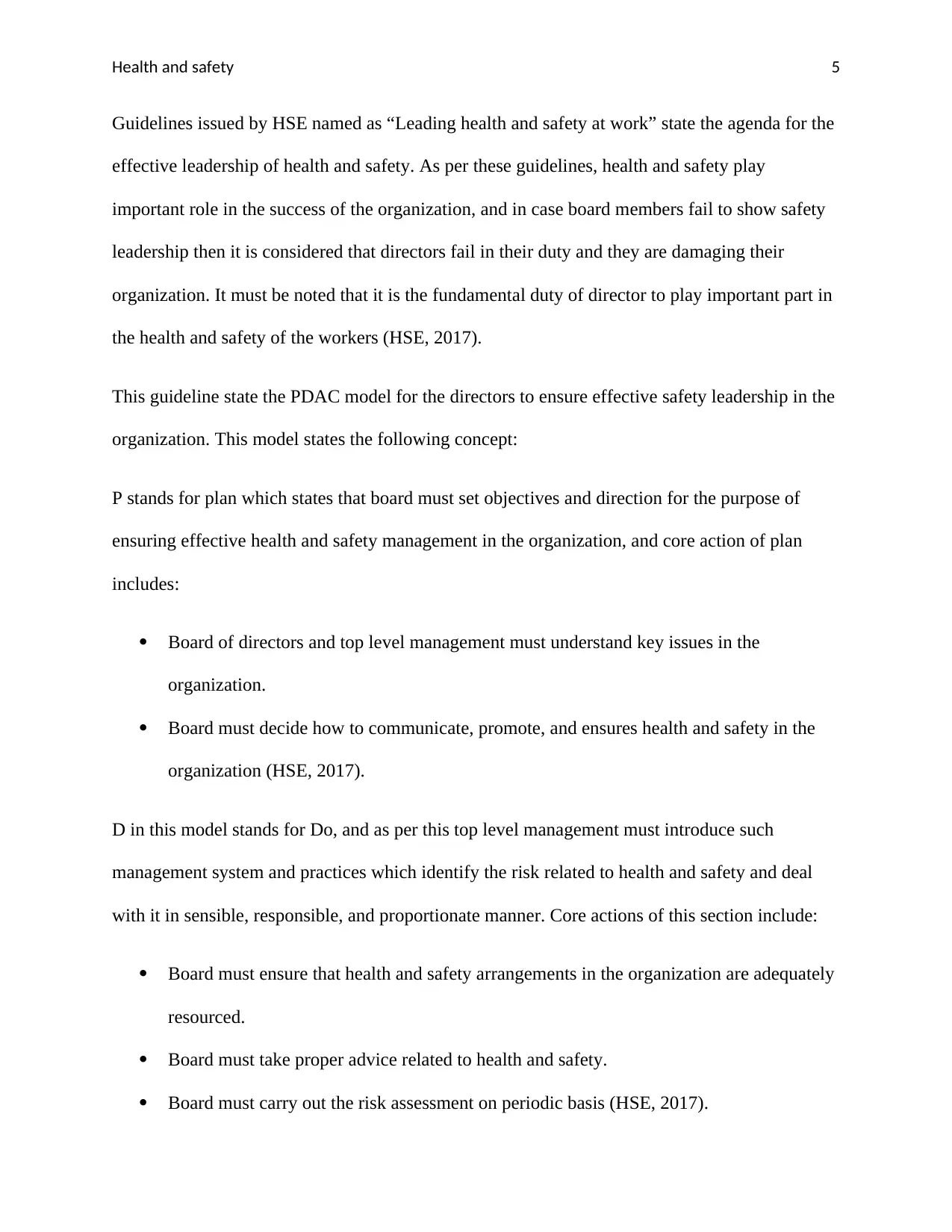
Health and safety 5
Guidelines issued by HSE named as “Leading health and safety at work” state the agenda for the
effective leadership of health and safety. As per these guidelines, health and safety play
important role in the success of the organization, and in case board members fail to show safety
leadership then it is considered that directors fail in their duty and they are damaging their
organization. It must be noted that it is the fundamental duty of director to play important part in
the health and safety of the workers (HSE, 2017).
This guideline state the PDAC model for the directors to ensure effective safety leadership in the
organization. This model states the following concept:
P stands for plan which states that board must set objectives and direction for the purpose of
ensuring effective health and safety management in the organization, and core action of plan
includes:
Board of directors and top level management must understand key issues in the
organization.
Board must decide how to communicate, promote, and ensures health and safety in the
organization (HSE, 2017).
D in this model stands for Do, and as per this top level management must introduce such
management system and practices which identify the risk related to health and safety and deal
with it in sensible, responsible, and proportionate manner. Core actions of this section include:
Board must ensure that health and safety arrangements in the organization are adequately
resourced.
Board must take proper advice related to health and safety.
Board must carry out the risk assessment on periodic basis (HSE, 2017).
Guidelines issued by HSE named as “Leading health and safety at work” state the agenda for the
effective leadership of health and safety. As per these guidelines, health and safety play
important role in the success of the organization, and in case board members fail to show safety
leadership then it is considered that directors fail in their duty and they are damaging their
organization. It must be noted that it is the fundamental duty of director to play important part in
the health and safety of the workers (HSE, 2017).
This guideline state the PDAC model for the directors to ensure effective safety leadership in the
organization. This model states the following concept:
P stands for plan which states that board must set objectives and direction for the purpose of
ensuring effective health and safety management in the organization, and core action of plan
includes:
Board of directors and top level management must understand key issues in the
organization.
Board must decide how to communicate, promote, and ensures health and safety in the
organization (HSE, 2017).
D in this model stands for Do, and as per this top level management must introduce such
management system and practices which identify the risk related to health and safety and deal
with it in sensible, responsible, and proportionate manner. Core actions of this section include:
Board must ensure that health and safety arrangements in the organization are adequately
resourced.
Board must take proper advice related to health and safety.
Board must carry out the risk assessment on periodic basis (HSE, 2017).
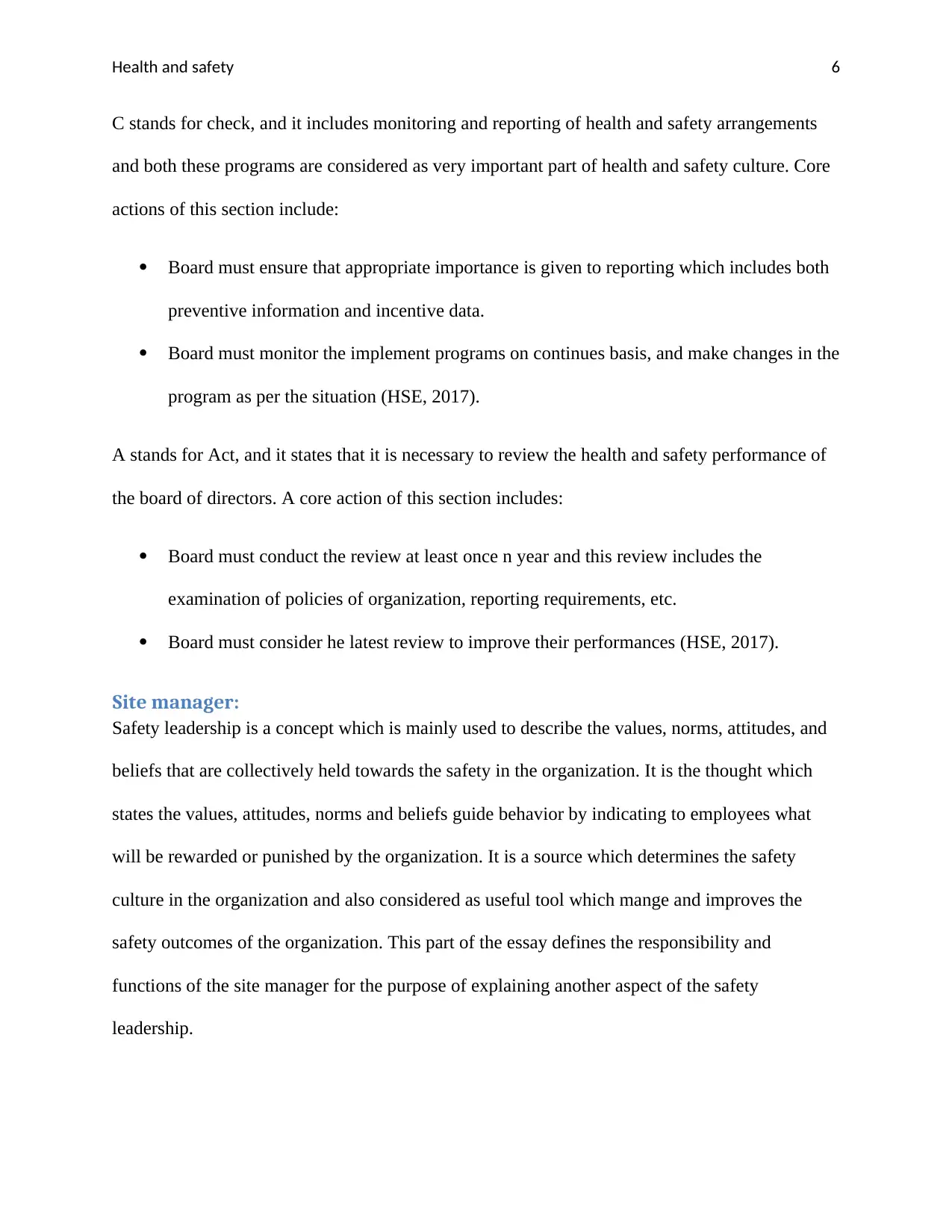
Health and safety 6
C stands for check, and it includes monitoring and reporting of health and safety arrangements
and both these programs are considered as very important part of health and safety culture. Core
actions of this section include:
Board must ensure that appropriate importance is given to reporting which includes both
preventive information and incentive data.
Board must monitor the implement programs on continues basis, and make changes in the
program as per the situation (HSE, 2017).
A stands for Act, and it states that it is necessary to review the health and safety performance of
the board of directors. A core action of this section includes:
Board must conduct the review at least once n year and this review includes the
examination of policies of organization, reporting requirements, etc.
Board must consider he latest review to improve their performances (HSE, 2017).
Site manager:
Safety leadership is a concept which is mainly used to describe the values, norms, attitudes, and
beliefs that are collectively held towards the safety in the organization. It is the thought which
states the values, attitudes, norms and beliefs guide behavior by indicating to employees what
will be rewarded or punished by the organization. It is a source which determines the safety
culture in the organization and also considered as useful tool which mange and improves the
safety outcomes of the organization. This part of the essay defines the responsibility and
functions of the site manager for the purpose of explaining another aspect of the safety
leadership.
C stands for check, and it includes monitoring and reporting of health and safety arrangements
and both these programs are considered as very important part of health and safety culture. Core
actions of this section include:
Board must ensure that appropriate importance is given to reporting which includes both
preventive information and incentive data.
Board must monitor the implement programs on continues basis, and make changes in the
program as per the situation (HSE, 2017).
A stands for Act, and it states that it is necessary to review the health and safety performance of
the board of directors. A core action of this section includes:
Board must conduct the review at least once n year and this review includes the
examination of policies of organization, reporting requirements, etc.
Board must consider he latest review to improve their performances (HSE, 2017).
Site manager:
Safety leadership is a concept which is mainly used to describe the values, norms, attitudes, and
beliefs that are collectively held towards the safety in the organization. It is the thought which
states the values, attitudes, norms and beliefs guide behavior by indicating to employees what
will be rewarded or punished by the organization. It is a source which determines the safety
culture in the organization and also considered as useful tool which mange and improves the
safety outcomes of the organization. This part of the essay defines the responsibility and
functions of the site manager for the purpose of explaining another aspect of the safety
leadership.
⊘ This is a preview!⊘
Do you want full access?
Subscribe today to unlock all pages.

Trusted by 1+ million students worldwide
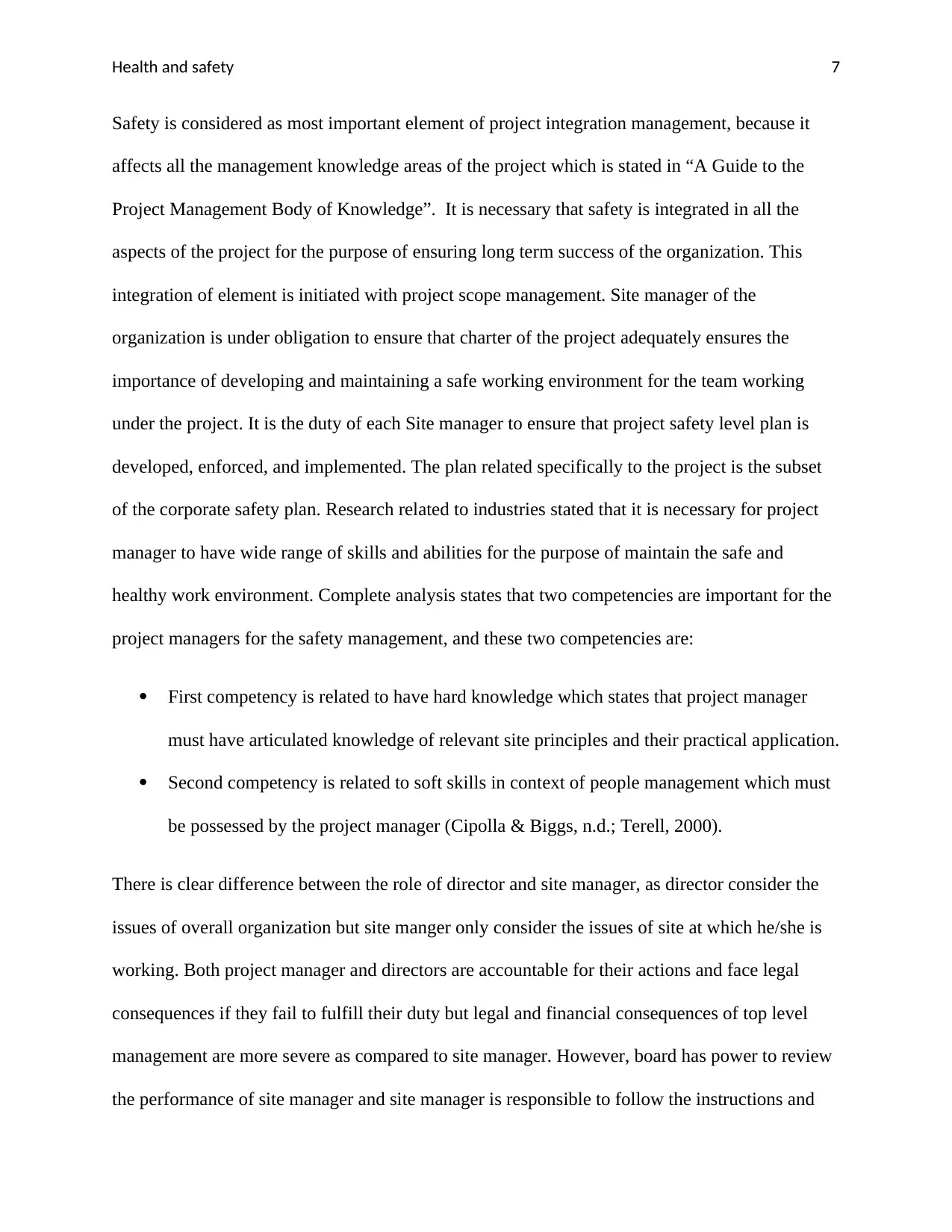
Health and safety 7
Safety is considered as most important element of project integration management, because it
affects all the management knowledge areas of the project which is stated in “A Guide to the
Project Management Body of Knowledge”. It is necessary that safety is integrated in all the
aspects of the project for the purpose of ensuring long term success of the organization. This
integration of element is initiated with project scope management. Site manager of the
organization is under obligation to ensure that charter of the project adequately ensures the
importance of developing and maintaining a safe working environment for the team working
under the project. It is the duty of each Site manager to ensure that project safety level plan is
developed, enforced, and implemented. The plan related specifically to the project is the subset
of the corporate safety plan. Research related to industries stated that it is necessary for project
manager to have wide range of skills and abilities for the purpose of maintain the safe and
healthy work environment. Complete analysis states that two competencies are important for the
project managers for the safety management, and these two competencies are:
First competency is related to have hard knowledge which states that project manager
must have articulated knowledge of relevant site principles and their practical application.
Second competency is related to soft skills in context of people management which must
be possessed by the project manager (Cipolla & Biggs, n.d.; Terell, 2000).
There is clear difference between the role of director and site manager, as director consider the
issues of overall organization but site manger only consider the issues of site at which he/she is
working. Both project manager and directors are accountable for their actions and face legal
consequences if they fail to fulfill their duty but legal and financial consequences of top level
management are more severe as compared to site manager. However, board has power to review
the performance of site manager and site manager is responsible to follow the instructions and
Safety is considered as most important element of project integration management, because it
affects all the management knowledge areas of the project which is stated in “A Guide to the
Project Management Body of Knowledge”. It is necessary that safety is integrated in all the
aspects of the project for the purpose of ensuring long term success of the organization. This
integration of element is initiated with project scope management. Site manager of the
organization is under obligation to ensure that charter of the project adequately ensures the
importance of developing and maintaining a safe working environment for the team working
under the project. It is the duty of each Site manager to ensure that project safety level plan is
developed, enforced, and implemented. The plan related specifically to the project is the subset
of the corporate safety plan. Research related to industries stated that it is necessary for project
manager to have wide range of skills and abilities for the purpose of maintain the safe and
healthy work environment. Complete analysis states that two competencies are important for the
project managers for the safety management, and these two competencies are:
First competency is related to have hard knowledge which states that project manager
must have articulated knowledge of relevant site principles and their practical application.
Second competency is related to soft skills in context of people management which must
be possessed by the project manager (Cipolla & Biggs, n.d.; Terell, 2000).
There is clear difference between the role of director and site manager, as director consider the
issues of overall organization but site manger only consider the issues of site at which he/she is
working. Both project manager and directors are accountable for their actions and face legal
consequences if they fail to fulfill their duty but legal and financial consequences of top level
management are more severe as compared to site manager. However, board has power to review
the performance of site manager and site manager is responsible to follow the instructions and
Paraphrase This Document
Need a fresh take? Get an instant paraphrase of this document with our AI Paraphraser
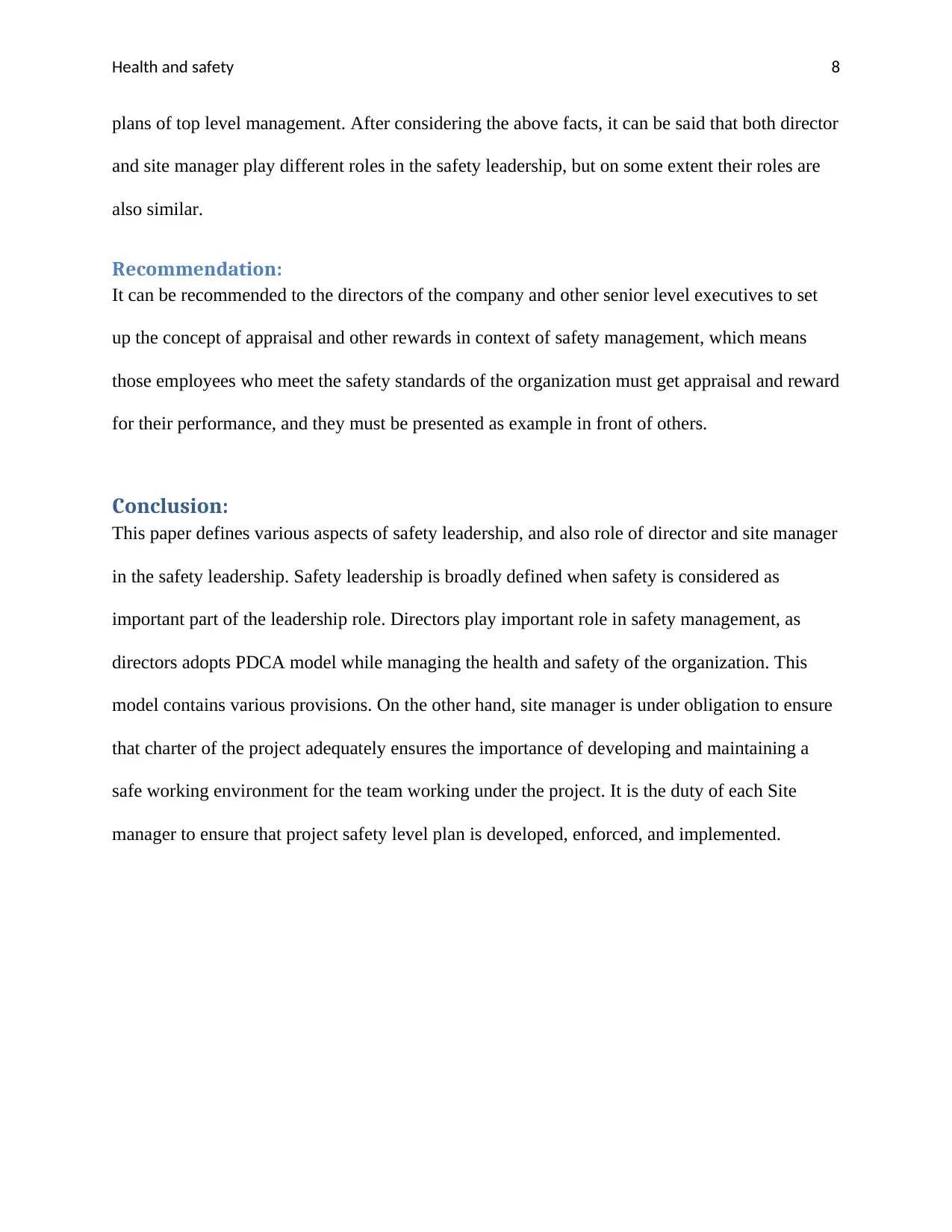
Health and safety 8
plans of top level management. After considering the above facts, it can be said that both director
and site manager play different roles in the safety leadership, but on some extent their roles are
also similar.
Recommendation:
It can be recommended to the directors of the company and other senior level executives to set
up the concept of appraisal and other rewards in context of safety management, which means
those employees who meet the safety standards of the organization must get appraisal and reward
for their performance, and they must be presented as example in front of others.
Conclusion:
This paper defines various aspects of safety leadership, and also role of director and site manager
in the safety leadership. Safety leadership is broadly defined when safety is considered as
important part of the leadership role. Directors play important role in safety management, as
directors adopts PDCA model while managing the health and safety of the organization. This
model contains various provisions. On the other hand, site manager is under obligation to ensure
that charter of the project adequately ensures the importance of developing and maintaining a
safe working environment for the team working under the project. It is the duty of each Site
manager to ensure that project safety level plan is developed, enforced, and implemented.
plans of top level management. After considering the above facts, it can be said that both director
and site manager play different roles in the safety leadership, but on some extent their roles are
also similar.
Recommendation:
It can be recommended to the directors of the company and other senior level executives to set
up the concept of appraisal and other rewards in context of safety management, which means
those employees who meet the safety standards of the organization must get appraisal and reward
for their performance, and they must be presented as example in front of others.
Conclusion:
This paper defines various aspects of safety leadership, and also role of director and site manager
in the safety leadership. Safety leadership is broadly defined when safety is considered as
important part of the leadership role. Directors play important role in safety management, as
directors adopts PDCA model while managing the health and safety of the organization. This
model contains various provisions. On the other hand, site manager is under obligation to ensure
that charter of the project adequately ensures the importance of developing and maintaining a
safe working environment for the team working under the project. It is the duty of each Site
manager to ensure that project safety level plan is developed, enforced, and implemented.
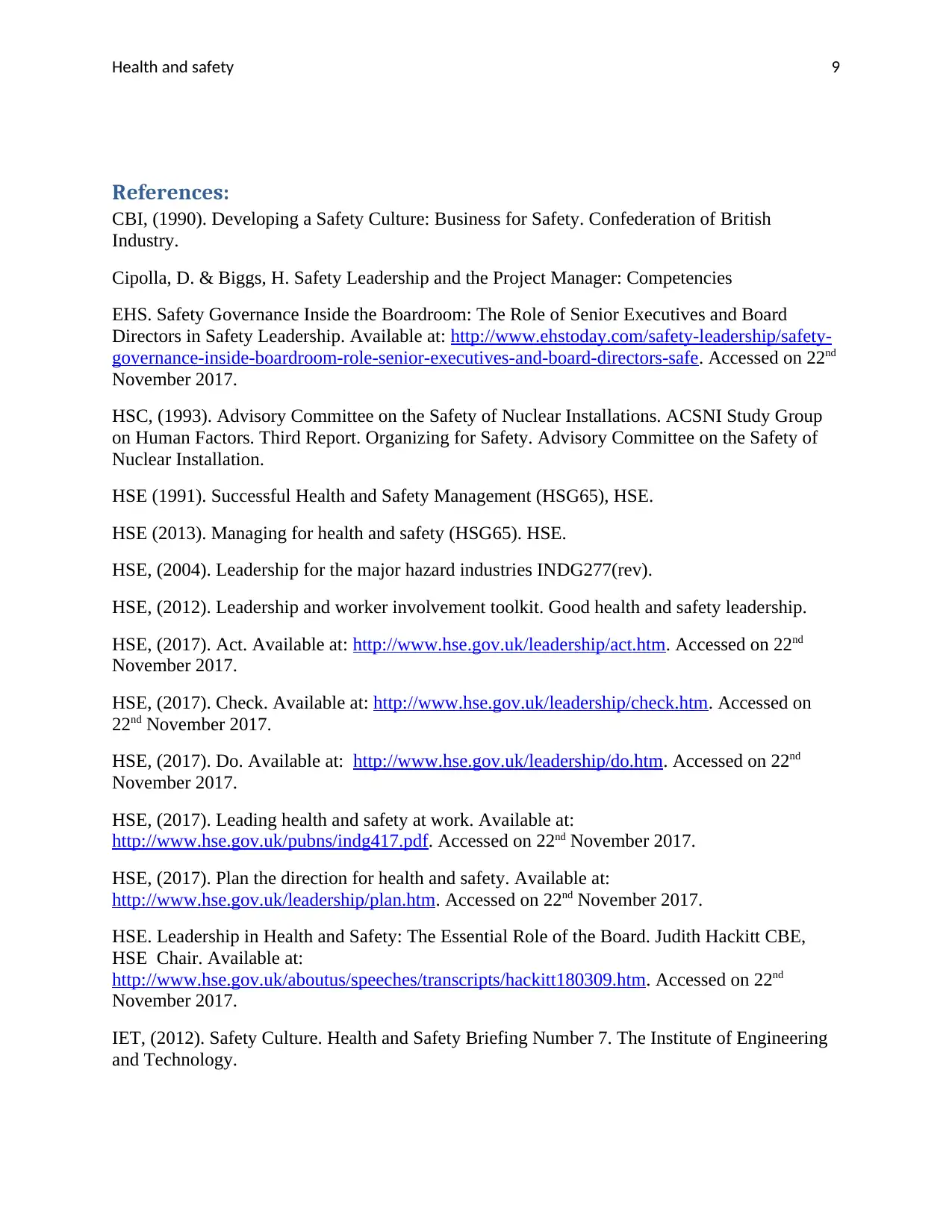
Health and safety 9
References:
CBI, (1990). Developing a Safety Culture: Business for Safety. Confederation of British
Industry.
Cipolla, D. & Biggs, H. Safety Leadership and the Project Manager: Competencies
EHS. Safety Governance Inside the Boardroom: The Role of Senior Executives and Board
Directors in Safety Leadership. Available at: http://www.ehstoday.com/safety-leadership/safety-
governance-inside-boardroom-role-senior-executives-and-board-directors-safe. Accessed on 22nd
November 2017.
HSC, (1993). Advisory Committee on the Safety of Nuclear Installations. ACSNI Study Group
on Human Factors. Third Report. Organizing for Safety. Advisory Committee on the Safety of
Nuclear Installation.
HSE (1991). Successful Health and Safety Management (HSG65), HSE.
HSE (2013). Managing for health and safety (HSG65). HSE.
HSE, (2004). Leadership for the major hazard industries INDG277(rev).
HSE, (2012). Leadership and worker involvement toolkit. Good health and safety leadership.
HSE, (2017). Act. Available at: http://www.hse.gov.uk/leadership/act.htm. Accessed on 22nd
November 2017.
HSE, (2017). Check. Available at: http://www.hse.gov.uk/leadership/check.htm. Accessed on
22nd November 2017.
HSE, (2017). Do. Available at: http://www.hse.gov.uk/leadership/do.htm. Accessed on 22nd
November 2017.
HSE, (2017). Leading health and safety at work. Available at:
http://www.hse.gov.uk/pubns/indg417.pdf. Accessed on 22nd November 2017.
HSE, (2017). Plan the direction for health and safety. Available at:
http://www.hse.gov.uk/leadership/plan.htm. Accessed on 22nd November 2017.
HSE. Leadership in Health and Safety: The Essential Role of the Board. Judith Hackitt CBE,
HSE Chair. Available at:
http://www.hse.gov.uk/aboutus/speeches/transcripts/hackitt180309.htm. Accessed on 22nd
November 2017.
IET, (2012). Safety Culture. Health and Safety Briefing Number 7. The Institute of Engineering
and Technology.
References:
CBI, (1990). Developing a Safety Culture: Business for Safety. Confederation of British
Industry.
Cipolla, D. & Biggs, H. Safety Leadership and the Project Manager: Competencies
EHS. Safety Governance Inside the Boardroom: The Role of Senior Executives and Board
Directors in Safety Leadership. Available at: http://www.ehstoday.com/safety-leadership/safety-
governance-inside-boardroom-role-senior-executives-and-board-directors-safe. Accessed on 22nd
November 2017.
HSC, (1993). Advisory Committee on the Safety of Nuclear Installations. ACSNI Study Group
on Human Factors. Third Report. Organizing for Safety. Advisory Committee on the Safety of
Nuclear Installation.
HSE (1991). Successful Health and Safety Management (HSG65), HSE.
HSE (2013). Managing for health and safety (HSG65). HSE.
HSE, (2004). Leadership for the major hazard industries INDG277(rev).
HSE, (2012). Leadership and worker involvement toolkit. Good health and safety leadership.
HSE, (2017). Act. Available at: http://www.hse.gov.uk/leadership/act.htm. Accessed on 22nd
November 2017.
HSE, (2017). Check. Available at: http://www.hse.gov.uk/leadership/check.htm. Accessed on
22nd November 2017.
HSE, (2017). Do. Available at: http://www.hse.gov.uk/leadership/do.htm. Accessed on 22nd
November 2017.
HSE, (2017). Leading health and safety at work. Available at:
http://www.hse.gov.uk/pubns/indg417.pdf. Accessed on 22nd November 2017.
HSE, (2017). Plan the direction for health and safety. Available at:
http://www.hse.gov.uk/leadership/plan.htm. Accessed on 22nd November 2017.
HSE. Leadership in Health and Safety: The Essential Role of the Board. Judith Hackitt CBE,
HSE Chair. Available at:
http://www.hse.gov.uk/aboutus/speeches/transcripts/hackitt180309.htm. Accessed on 22nd
November 2017.
IET, (2012). Safety Culture. Health and Safety Briefing Number 7. The Institute of Engineering
and Technology.
⊘ This is a preview!⊘
Do you want full access?
Subscribe today to unlock all pages.

Trusted by 1+ million students worldwide
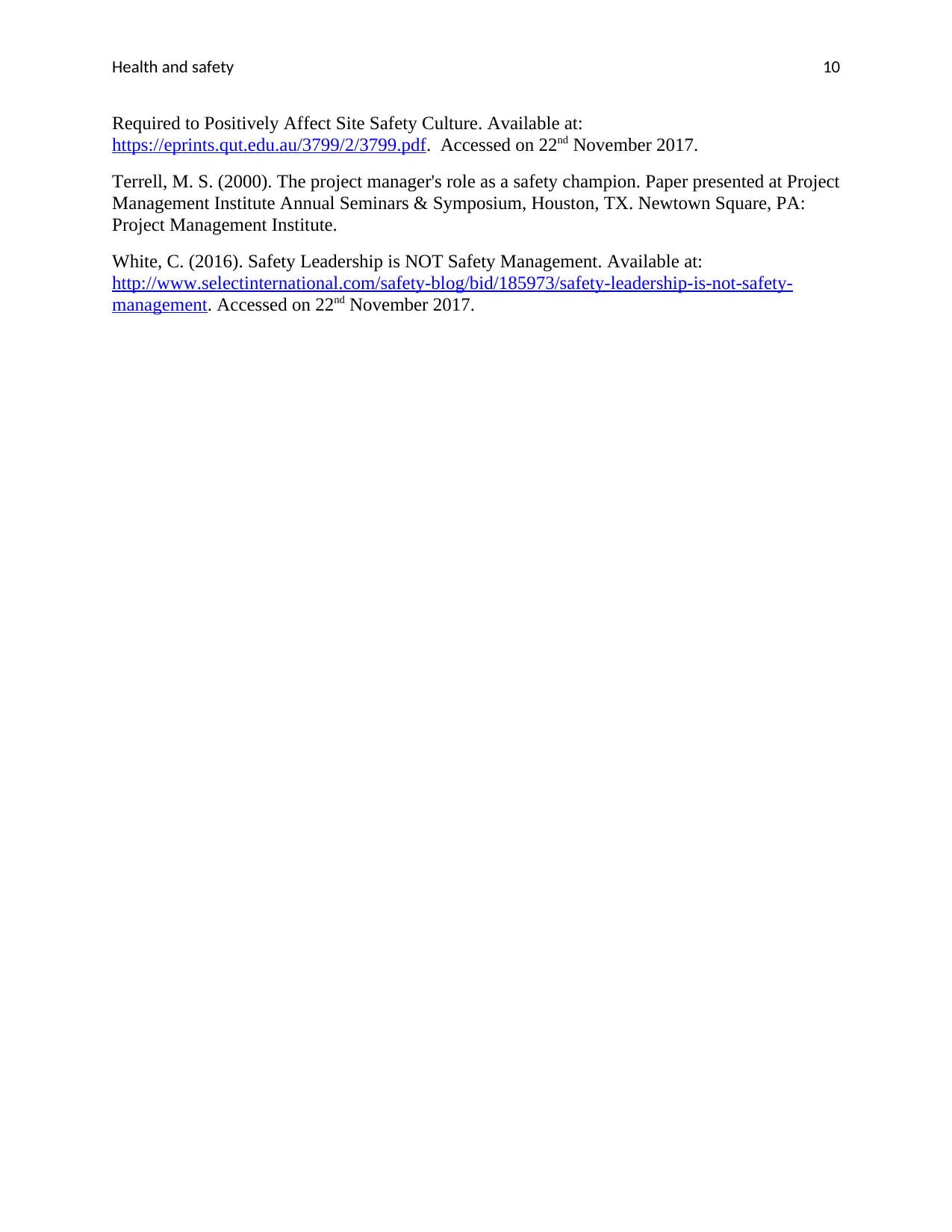
Health and safety 10
Required to Positively Affect Site Safety Culture. Available at:
https://eprints.qut.edu.au/3799/2/3799.pdf. Accessed on 22nd November 2017.
Terrell, M. S. (2000). The project manager's role as a safety champion. Paper presented at Project
Management Institute Annual Seminars & Symposium, Houston, TX. Newtown Square, PA:
Project Management Institute.
White, C. (2016). Safety Leadership is NOT Safety Management. Available at:
http://www.selectinternational.com/safety-blog/bid/185973/safety-leadership-is-not-safety-
management. Accessed on 22nd November 2017.
Required to Positively Affect Site Safety Culture. Available at:
https://eprints.qut.edu.au/3799/2/3799.pdf. Accessed on 22nd November 2017.
Terrell, M. S. (2000). The project manager's role as a safety champion. Paper presented at Project
Management Institute Annual Seminars & Symposium, Houston, TX. Newtown Square, PA:
Project Management Institute.
White, C. (2016). Safety Leadership is NOT Safety Management. Available at:
http://www.selectinternational.com/safety-blog/bid/185973/safety-leadership-is-not-safety-
management. Accessed on 22nd November 2017.
1 out of 10
Related Documents
Your All-in-One AI-Powered Toolkit for Academic Success.
+13062052269
info@desklib.com
Available 24*7 on WhatsApp / Email
![[object Object]](/_next/static/media/star-bottom.7253800d.svg)
Unlock your academic potential
© 2024 | Zucol Services PVT LTD | All rights reserved.





